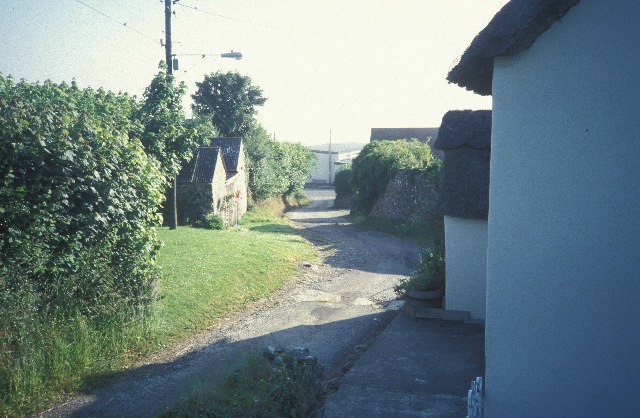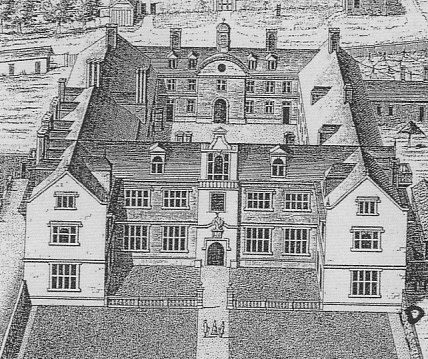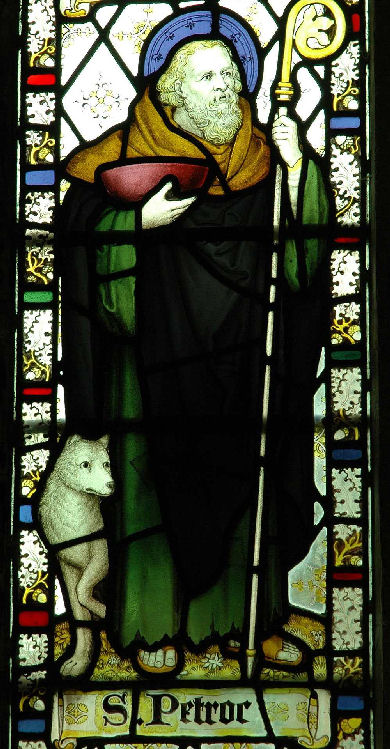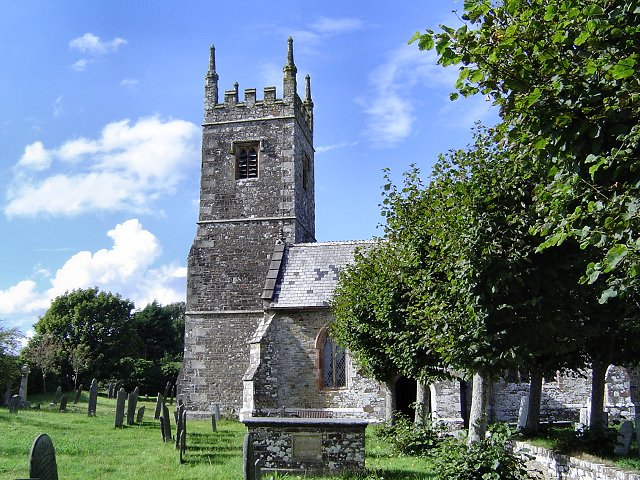|
Petrockstowe
Petrockstowe (or Petrockstow) is a small village and civil parish in the district of Torridge in Northern Devon, England. Its population in 2001 was 379, hardly different from the figure of 385 recorded in 1901. The southern boundary of the parish lies on the River Torridge, and it is surrounded, clockwise from the north, by the parishes of Peters Marland, Merton, Huish, Meeth, Highampton and Buckland Filleigh. The village lies about four miles NNW of the town of Hatherleigh and is some two miles west of the A386 road, accessible only by minor roads. Etymology The place was called Petrocestoua in the Domesday Book in 1086, in 1150 Petrochestona, and in 1202 Petroc. By 1272 it was called Patrichestowe and Petrokestowe in 1297. In 1535 it was called Stowe S"e'i Petroci. All the names mean St Petroc's place, for the patron saint Petroc. Stowe means "place of burial or the shrine of relics of the saint". By 1910, it was also called Padstow. The village is referred to by bo ... [...More Info...] [...Related Items...] OR: [Wikipedia] [Google] [Baidu] |
Heanton Satchville, Petrockstowe
Heanton Satchville was a historic manor in the parish of Petrockstowe, North Devon, England. With origins in the Domesday manor of Hantone, it was first recorded as belonging to the Yeo family in the mid-14th century and was then owned successively by the Rolle, Walpole and Trefusis families. The mansion house was destroyed by fire in 1795. In 1812 Lord Clinton purchased the manor and mansion of nearby Huish, renamed it Heanton Satchville, and made it his seat. The nearly-forgotten house was featured in the 2005 edition of Rosemary Lauder's "Vanished Houses of North Devon". A farmhouse now occupies the former stable block with a large tractor shed where the house once stood. The political power-base of the Rolle family of Heanton Satchville was the pocket borough seat of Callington in Cornwall, acquired in 1601 when Robert Rolle (died 1633) purchased the manor of Callington.Hunneyball (2010) Description of mansion The mansion was at one time "one of the most imposing ... [...More Info...] [...Related Items...] OR: [Wikipedia] [Google] [Baidu] |
Huish, Torridge
Huish (anciently ''Hiwis'') is a small village, civil parish and former manor in the Torridge district of Devon, England. The eastern boundary of the parish is formed by the River Torridge and the western by the Rivers Mere and Little Mere, and it is surrounded, clockwise from the north, by the parishes of Merton, Dolton, Meeth and Petrockstowe. In 2001 the population of the parish was 49, down from 76 in 1901. The village lies just off the A386 road, about five and a half miles north of Hatherleigh, and about seven miles south of Great Torrington. It was a member of the historic hundred of Shebbear and was in the deanery of Torrington. The majority of the parish consists of parkland belonging to Heanton Satchville, the seat of Baron Clinton; the mansion-house is a few hundred yards to the north of the church. Parish church The church, dedicated to St James the Less, was heavily restored in 1873 by the 20th Baron Clinton to the designs of George Edmund Street. The work ... [...More Info...] [...Related Items...] OR: [Wikipedia] [Google] [Baidu] |
Merton, Devon
Merton is a village, ecclesiastical parish, former manor and civil parish administered by the local government district of Torridge, Devon, England. The parish, which lies about five miles south east of the town of Great Torrington, is surrounded clockwise from the north by the parishes of Little Torrington, Beaford, Dolton, Huish, Petrockstowe and Peters Marland. In 2001 its population was 331, down from the 507 residents it had in 1901. The eastern and northern boundaries of the parish follow the loops of the River Torridge and the other sides are defined by the River Mere. The village forms part of the electoral ward of Clinton. The population at the 2011 census was 1,537. The village is on the A386 road between Meeth and Great Torrington. The parish church, on the west side of the village, is dedicated to All Saints and dates from around 1400. It suffered a heavy Victorian restoration between 1872 and 1875 by R. M. Fulford, but the east window of the north chapel ret ... [...More Info...] [...Related Items...] OR: [Wikipedia] [Google] [Baidu] |
Devon
Devon ( , historically known as Devonshire , ) is a ceremonial and non-metropolitan county in South West England. The most populous settlement in Devon is the city of Plymouth, followed by Devon's county town, the city of Exeter. Devon is a coastal county with cliffs and sandy beaches. Home to the largest open space in southern England, Dartmoor (), the county is predominately rural and has a relatively low population density for an English county. The county is bordered by Somerset to the north east, Dorset to the east, and Cornwall to the west. The county is split into the non-metropolitan districts of East Devon, Mid Devon, North Devon, South Hams, Teignbridge, Torridge, West Devon, Exeter, and the unitary authority areas of Plymouth, and Torbay. Combined as a ceremonial county, Devon's area is and its population is about 1.2 million. Devon derives its name from Dumnonia (the shift from ''m'' to ''v'' is a typical Celtic consonant shift) ... [...More Info...] [...Related Items...] OR: [Wikipedia] [Google] [Baidu] |
Shebbear Hundred
Shebbear Hundred was the name of one of the thirty-two 19th century hundreds of Devon, England. The hundred of Shebbear was organized by the 13th century with many of the parishes of the ancient Domesday hundred of Merton. Accessed 25 Dec 2021.  The es in the of Shebbear were:
The es in the of Shebbear were:
|
Saint Petroc
Saint Petroc or Petrock ( lat-med, Petrocus; cy, Pedrog; french: link=no, Perreux; ) was a British prince and Christian saint. Probably born in South Wales, he primarily ministered to the Britons of Devon (Dewnans) and Cornwall (Kernow) then forming the kingdom of Dumnonia where he is associated with a monastery at Padstow, which is named after him (Pedroc-stowe, or 'Petrock's Place'). Padstow appears to have been his earliest major cult centre, but Bodmin became the major centre for his veneration when his relics were moved to the monastery there in the later ninth century. Bodmin monastery became one of the wealthiest Cornish foundations by the eleventh century. There is a second ancient dedication to him nearby at Little Petherick or "Saint Petroc Minor". In Devon ancient dedications total a probable seventeen (plus Timberscombe just over the border in Somerset), mostly coastal and including one within the old Roman walls of Exeter as well as the villages of Petrockstowe ... [...More Info...] [...Related Items...] OR: [Wikipedia] [Google] [Baidu] |
Peters Marland
Peters Marland is a small village and civil parish in the local government district of Torridge, Devon, England. The parish, which lies about four miles south of the town of Great Torrington, is surrounded clockwise from the north by the parishes of Little Torrington, Merton, Petrockstowe, Buckland Filleigh, Shebbear and Langtree. In 2001 its population was 234, down from the 286 residents it had in 1901. In 1850 the parish was recorded as covering 2,200 acres with 351 parishioners. At that time most of the land within the parish belonged to Rev. John Moore-Stevens (died 1865), Archdeacon of Exeter, whose son was living at Winscott House in the parish; much also belonged to G. Oldham of Twigbear. Both Winscott and Twigbear are former manors that have their origins before the Norman Conquest, as also are Week and Winswell in the parish. The parish church, in the village, is dedicated to St Peter. It was extensively restored in the 1860s by the Moore-Stevens family and is, acco ... [...More Info...] [...Related Items...] OR: [Wikipedia] [Google] [Baidu] |
St Petroc
Saint Petroc or Petrock ( lat-med, Petrocus; cy, Pedrog; french: link=no, Perreux; ) was a British prince and Christian saint. Probably born in South Wales, he primarily ministered to the Britons of Devon (Dewnans) and Cornwall (Kernow) then forming the kingdom of Dumnonia where he is associated with a monastery at Padstow, which is named after him (Pedroc-stowe, or 'Petrock's Place'). Padstow appears to have been his earliest major cult centre, but Bodmin became the major centre for his veneration when his relics were moved to the monastery there in the later ninth century. Bodmin monastery became one of the wealthiest Cornish foundations by the eleventh century. There is a second ancient dedication to him nearby at Little Petherick or "Saint Petroc Minor". In Devon ancient dedications total a probable seventeen (plus Timberscombe just over the border in Somerset), mostly coastal and including one within the old Roman walls of Exeter as well as the villages of Petrockstowe ... [...More Info...] [...Related Items...] OR: [Wikipedia] [Google] [Baidu] |
Buckland Filleigh
Buckland Filleigh is a village, civil parish and former manor in the Torridge district of North Devon, England, situated about 8 miles south of the town of Great Torrington. According to the 2001 census, the parish had a population of 170. It is surrounded clockwise from the north by the parishes of Peters Marland, Petrockstowe, Highampton, Sheepwash and Shebbear. Within the parish is the manor house known as Buckland House, damaged by fire in 1798 and rebuilt in 1810 in the neo-classical style by John Inglett Fortescue (1758–1841) to the designs of the architect James Green. History The manor of Buckland Filleigh is listed in the Domesday Book Domesday Book () – the Middle English spelling of "Doomsday Book" – is a manuscript record of the "Great Survey" of much of England and parts of Wales completed in 1086 by order of King William I, known as William the Conqueror. The manus ... and was later held successively by the families of de Filleigh, Denzell, Fort ... [...More Info...] [...Related Items...] OR: [Wikipedia] [Google] [Baidu] |
Edward I Of England
Edward I (17/18 June 1239 – 7 July 1307), also known as Edward Longshanks and the Hammer of the Scots, was King of England and Lord of Ireland from 1272 to 1307. Concurrently, he ruled the duchies of Aquitaine and Gascony as a vassal of the French king. Before his accession to the throne, he was commonly referred to as the Lord Edward. The eldest son of Henry III, Edward was involved from an early age in the political intrigues of his father's reign, which included a rebellion by the English barons. In 1259, he briefly sided with a baronial reform movement, supporting the Provisions of Oxford. After reconciliation with his father, however, he remained loyal throughout the subsequent armed conflict, known as the Second Barons' War. After the Battle of Lewes, Edward was held hostage by the rebellious barons, but escaped after a few months and defeated the baronial leader Simon de Montfort at the Battle of Evesham in 1265. Within two years the rebellion was ex ... [...More Info...] [...Related Items...] OR: [Wikipedia] [Google] [Baidu] |
Robert Warelwast
__NOTOC__ Robert Warelwast (died 1155) was a medieval Bishop of Exeter. Life Warelwast and his successor, Robert of Chichester are often confused.Barlow ''English Church'' p. 93 Warelwast was the nephew of the previous bishop, William Warelwast, and was appointed archdeacon of Exeter by his uncle.Crouch ''Reign of King Stephen'' p. 302 He had been educated at Laon,Chibnall ''Anglo-Norman England'' p. 128 sent there by his uncle to study under Master Anselm of Laon.Barlow "Warelwast, Robert de" ''Oxford Dictionary of National Biography'' Warelwast was nominated on 10 April 1138 at a royal council held at Northampton.Appleby ''Troubled Reign'' p. 47 Probably, he was elected by the cathedral chapter and his election was formally accepted by King Stephen of England at Northampton. He was consecrated on 18 December 1138 by the papal legate Alberic, because the archbishopric of Canterbury was vacant. Warelwast went to the Lateran Council held by Pope Innocent II in 1139.Appleby ''Tr ... [...More Info...] [...Related Items...] OR: [Wikipedia] [Google] [Baidu] |
Bishop Of Exeter
The Bishop of Exeter is the ordinary of the Church of England Diocese of Exeter in the Province of Canterbury. Since 30 April 2014 the ordinary has been Robert Atwell.Diocese of Exeter – Election of new Bishop of Exeter formally confirmed (Accessed 9 May 2014) From the first until the sixteenth century the Bishops of were in with the |






